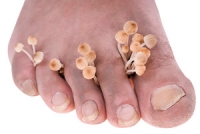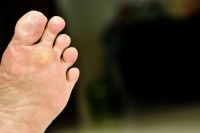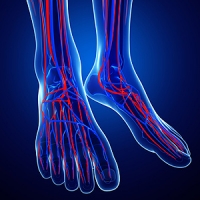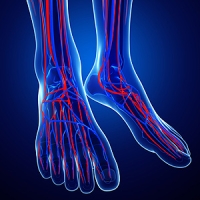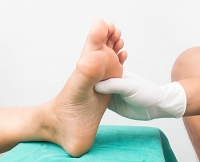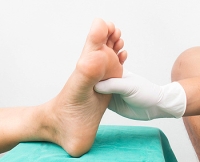
Blog (822)
How to Avoid Toenail Fungus
Toenail fungus, also known as onychomycosis, is a relatively common health condition. Common symptoms of toenail fungus include yellow or brown nails, brittleness, or nails that may lift up from the nail bed. The fungus is contagious and can spread from nail to nail or even infect the foot and cause athlete’s foot. Without treatment, the fungus can worsen, which may be a contributing factor in experiencing pain while wearing shoes. Avoiding toenail fungus is important in maintaining healthy feet. Choosing breathable footwear, wearing proper shoes in public showers, and using foot powders to keep the feet dry can all help in avoiding toenail fungus. Keeping toenails short is also important and aids in preventing ingrown toenails. Additionally, it’s advised that shoes or nail clippers should not be shared, as this may promote spreading of the fungus. If a pedicure is desired, it’s important that the sanitation of pedicure tools occur. For all conditions related to the foot, including toenail fungus, it is important to seek help from a podiatrist.
For more information about treatment, contact Dr. Kenneth Donovan of Advanced Care Foot and Ankle. Our doctor can provide the care you need to keep you pain-free and on your feet.
Toenail Fungus Treatment
Toenail fungus is a condition that affects many people and can be especially hard to get rid of. Fortunately, there are several methods to go about treating and avoiding it.
Antifungals & Deterrence
Oral antifungal medicine has been shown to be effective in many cases. It is important to consult with a podiatrist to determine the proper regiment for you, or potentially explore other options.
Applying foot powder on the feet and shoes helps keep the feet free of moisture and sweat.
Sandals or open toed shoes – Wearing these will allow air movement and help keep feet dry. They also expose your feet to light, which fungus cannot tolerate. Socks with moisture wicking material also help as well.
If you have any questions please feel free to contact one of our offices located in Warren, Livingston, and Toms River, NJ . We offer the newest diagnostic tools and technology to treat your foot and ankle needs.
Do Your Child’s Feet Hurt?
Do Your Child's Feet Hurt?
What is Hyperhidrosis?
The purpose of sweating is to regulate the body’s temperature. When this happens excessively, it’s known as hyperhidrosis. Most of the millions of people affected by this condition often feel a loss of control because sweating can occur independent of physical exertion. It may begin in childhood and is thought to be a genetically inherited condition. In severe cases, sweat can drip from the feet, possibly causing social situations to be uncomfortable. Anxiety, depression, infections and skin irritations may occur, resulting in difficulty in handling this condition psychologically. Typically, it helps to identify specific conditions that lead to excessive sweating. To reduce discomfort, keeping the feet dry is advised. Medications and surgery are possible treatment options to regulate this disorder. Please consult with a podiatrist if you have questions about excessive sweating from the feet.
If you are suffering from hyperhidrosis contact Dr. Kenneth Donovan of Advanced Care Foot and Ankle. Our doctor can provide the care you need to attend to all of your foot and ankle needs.
Hyperhidrosis of the Feet
Hyperhidrosis is a rare disorder that can cause people to have excessive sweating of their feet. This can usually occur all on its own without rigorous activity involved. People who suffer from hyperhidrosis may also experience sweaty palms.
Although it is said that sweating is a healthy process meant to cool down the body temperature and to maintain a proper internal temperature, hyperhidrosis may prove to be a huge hindrance on a person’s everyday life.
Plantar hyperhidrosis is considered to be the main form of hyperhidrosis. Secondary hyperhidrosis can refer to sweating that occurs in areas other than the feet or hands and armpits. Often this may be a sign of it being related to another medical condition such as menopause, hyperthyroidism and even Parkinson’s disease.
In order to alleviate this condition, it is important to see your doctor so that they may prescribe the necessary medications so that you can begin to live a normal life again. If this is left untreated, it is said that it will persist throughout an individual’s life.
A last resort approach would be surgery, but it is best to speak with your doctor to find out what may be the best treatment for you.
If you have any questions please feel free to contact one of our offices located in Warren, Livingston, and Toms River, NJ. We offer the newest diagnostic and treatment technologies for all your foot and ankle needs.
Why Are My Feet Cold?
The feet may feel cold when there are environmental stresses, such as the temperature dropping. This may cause oxygen deficiency and turn the feet blue in color, a condition called cyanosis. When the natural circulation is restored, this condition disappears. There are other causes of poor blood circulation, including the inability to produce normal levels of red blood cells, commonly known as anemia. Typically, improvement may be achieved through diet, in addition to taking nutritional supplements. Diabetes may be another cause, and this disease can have very serious effects on the feet. It may result in nerve damage, causing the feet to feel cold. If your feet feel cold a lot of the time, a consultation with a podiatrist may be advised.
Poor circulation is a serious condition and needs immediate medical attention. If you have any concerns with poor circulation in your feet contact Dr. Kenneth Donovan of Advanced Care Foot and Ankle. Our doctor will treat your foot and ankle needs.
Poor Circulation in the Feet
Poor blood circulation in the feet and legs is can be caused by peripheral artery disease (PAD), which is the result of a buildup of plaque in the arteries.
Plaque buildup or atherosclerosis results from excess calcium and cholesterol in the bloodstream. This can restrict the amount of blood which can flow through the arteries. Poor blood circulation in the feet and legs are sometimes caused by inflammation in the blood vessels, known as vasculitis.
Causes
Lack of oxygen and oxygen from poor blood circulation restricts muscle growth and development. It can also cause:
- Muscle pain, stiffness, or weakness
- Numbness or cramping in the legs
Those who have diabetes or smoke are at greatest risk for poor circulation, as are those who are over 50. If you have poor circulation in the feet and legs it may be caused by PAD and is important to make changes to your lifestyle in order to reduce risk of getting a heart attack or stroke. Exercise and maintaining a healthy lifestyle will dramatically improve conditions.
As always, see a podiatrist as he or she will assist in finding a regimen that suits you. A podiatrist can also prescribe you any needed medication.
If you have any questions please feel free to contact one of our offices located in Warren, Livingston, and Toms River, NJ. We offer the newest diagnostic and treatment technologies for all your foot and ankle needs.
Read more about Causes, Symptoms, and Treatment of Poor Blood Circulation in the Feet
Why Are My Feet Cold?
 The feet may feel cold when there are environmental stresses, such as the temperature dropping. This may cause oxygen deficiency and turn the feet blue in color, a condition called cyanosis. When the natural circulation is restored, this condition disappears. There are other causes of poor blood circulation, including the inability to produce normal levels of red blood cells, commonly known as anemia. Typically, improvement may be achieved through diet, in addition to taking nutritional supplements. Diabetes may be another cause, and this disease can have very serious effects on the feet. It may result in nerve damage, causing the feet to feel cold. If your feet feel cold a lot of the time, a consultation with a podiatrist may be advised.
The feet may feel cold when there are environmental stresses, such as the temperature dropping. This may cause oxygen deficiency and turn the feet blue in color, a condition called cyanosis. When the natural circulation is restored, this condition disappears. There are other causes of poor blood circulation, including the inability to produce normal levels of red blood cells, commonly known as anemia. Typically, improvement may be achieved through diet, in addition to taking nutritional supplements. Diabetes may be another cause, and this disease can have very serious effects on the feet. It may result in nerve damage, causing the feet to feel cold. If your feet feel cold a lot of the time, a consultation with a podiatrist may be advised.
Poor circulation is a serious condition and needs immediate medical attention. If you have any concerns with poor circulation in your feet contact Dr. Kenneth Donovan of Advanced Care Foot and Ankle. Our doctor will treat your foot and ankle needs.
Poor Circulation in the Feet
Poor blood circulation in the feet and legs is can be caused by peripheral artery disease (PAD), which is the result of a buildup of plaque in the arteries.
Plaque buildup or atherosclerosis results from excess calcium and cholesterol in the bloodstream. This can restrict the amount of blood which can flow through the arteries. Poor blood circulation in the feet and legs are sometimes caused by inflammation in the blood vessels, known as vasculitis.
Causes
Lack of oxygen and oxygen from poor blood circulation restricts muscle growth and development. It can also cause:
- Muscle pain, stiffness, or weakness
- Numbness or cramping in the legs
- Skin discoloration
- Slower nail & hair growth
- Erectile dysfunction
Those who have diabetes or smoke are at greatest risk for poor circulation, as are those who are over 50. If you have poor circulation in the feet and legs it may be caused by PAD and is important to make changes to your lifestyle in order to reduce risk of getting a heart attack or stroke. Exercise and maintaining a healthy lifestyle will dramatically improve conditions.
As always, see a podiatrist as he or she will assist in finding a regimen that suits you. A podiatrist can also prescribe you any needed medication.
If you have any questions please feel free to contact one of our offices located in Warren, Livingston, and Toms River, NJ . We offer the newest diagnostic and treatment technologies for all your foot and ankle needs.
Rheumatoid Arthritis in the Feet and Ankles
It can be painful to walk for those who have rheumatoid arthritis. A large percentage of people diagnosed with this disease may experience pain in their ankles and joints at some point in their lives. Common symptoms may include tenderness, swelling, and difficulty bending the foot. Emotional symptoms may also occur, including feelings of helplessness, anxiety and depression. Excessive fatigue may be another sign of rheumatoid arthritis. When these symptoms are controlled, further damage to tissues and joints may be prevented. Proper medication, when taken correctly, can be effective in managing relief. When early treatment is initiated, the goal of remission is much more likely. Practicing low-impact exercise such as yoga, swimming or walking is beneficial in strengthening the joints and muscles.
Because RA affects more than just your joints, including the joints in your feet and ankles, it is important to seek early diagnosis from your podiatrist if you feel like the pain in your feet might be caused by RA. For more information, contact Dr. Kenneth Donovan of Advanced Care Foot and Ankle. Our doctor will assist you with all of your podiatric concerns.
What Is Rheumatoid Arthritis?
Rheumatoid Arthritis (RA) is an autoimmune disorder in which the body’s own immune system attacks the membranes surrounding the joints. Inflammation of the lining and eventually the destruction of the joint’s cartilage and bone occur, causing severe pain and immobility.
Rheumatoid Arthritis of the Feet
Although RA usually attacks multiple bones and joints throughout the entire body, almost 90 percent of cases result in pain in the foot or ankle area.
Symptoms
- Swelling and pain in the feet
- Stiffness in the feet
- Pain on the ball or sole of feet
- Joint shift and deformation
Diagnosis
Quick diagnosis of RA in the feet is important so that the podiatrist can treat the area effectively. Your doctor will ask you about your medical history, occupation, and lifestyle to determine the origin of the condition. Rheumatoid Factor tests help to determine if someone is affected by the disease.
If you have any questions please feel free to contact one of our offices located in Warren, Livingston, and Toms River, NJ. We offer the newest diagnostic and treatment technologies for all your foot and ankle needs.
Rheumatoid Arthritis in the Feet and Ankles
 It can be painful to walk for those who have rheumatoid arthritis. A large percentage of people diagnosed with this disease may experience pain in their ankles and joints at some point in their lives. Common symptoms may include tenderness, swelling, and difficulty bending the foot. Emotional symptoms may also occur, including feelings of helplessness, anxiety and depression. Excessive fatigue may be another sign of rheumatoid arthritis. When these symptoms are controlled, further damage to tissues and joints may be prevented. Proper medication, when taken correctly, can be effective in managing relief. When early treatment is initiated, the goal of remission is much more likely. Practicing low-impact exercise such as yoga, swimming or walking is beneficial in strengthening the joints and muscles.
It can be painful to walk for those who have rheumatoid arthritis. A large percentage of people diagnosed with this disease may experience pain in their ankles and joints at some point in their lives. Common symptoms may include tenderness, swelling, and difficulty bending the foot. Emotional symptoms may also occur, including feelings of helplessness, anxiety and depression. Excessive fatigue may be another sign of rheumatoid arthritis. When these symptoms are controlled, further damage to tissues and joints may be prevented. Proper medication, when taken correctly, can be effective in managing relief. When early treatment is initiated, the goal of remission is much more likely. Practicing low-impact exercise such as yoga, swimming or walking is beneficial in strengthening the joints and muscles.
Because RA affects more than just your joints, including the joints in your feet and ankles, it is important to seek early diagnosis from your podiatrist if you feel like the pain in your feet might be caused by RA. For more information, contact Dr. Kenneth Donovan of Advanced Care Foot and Ankle. Our doctor will assist you with all of your podiatric concerns.
What Is Rheumatoid Arthritis?
Rheumatoid Arthritis (RA) is an autoimmune disorder in which the body’s own immune system attacks the membranes surrounding the joints. Inflammation of the lining and eventually the destruction of the joint’s cartilage and bone occur, causing severe pain and immobility.
Rheumatoid Arthritis of the Feet
Although RA usually attacks multiple bones and joints throughout the entire body, almost 90 percent of cases result in pain in the foot or ankle area.
Symptoms
- Swelling and pain in the feet
- Stiffness in the feet
- Pain on the ball or sole of feet
- Joint shift and deformation
Diagnosis
Quick diagnosis of RA in the feet is important so that the podiatrist can treat the area effectively. Your doctor will ask you about your medical history, occupation, and lifestyle to determine the origin of the condition. Rheumatoid Factor tests help to determine if someone is affected by the disease.
If you have any questions please feel free to contact one of our offices located in Warren, Livingston, and Toms River, NJ . We offer the newest diagnostic and treatment technologies for all your foot and ankle needs.
